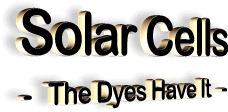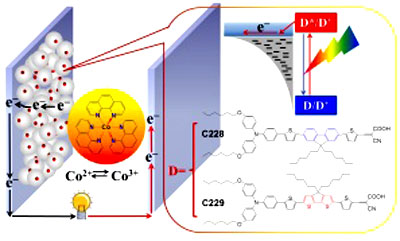|
31 October 2011
Precisely engineered dye compounds take
inexpensive, corrosive-free dye-based photovoltaic devices to record
levels of efficiency.
The push-pull dye C229 is coupled with a cobalt-based electrolyte
to achieve high solar
energy conversion efficiency. The dye-sensitized solar cell (DSC) is a next-generation photovoltaic technology with the potential to reduce the cost of solar energy production to levels comparable to that of fossil fuel-based electricity generation.
DSCs use a mix of dye molecules and
inexpensive
titanium dioxide (TiO2)
nanoparticles to convert sunlight into electricity, and can be
easily and cheaply fabricated into thin, large-area sheets using
simple screen-printing techniques. Despite the promise of this
technology, however, achieving the high conversion efficiencies
needed to approach commercial viability has meant using
resource-limited materials such as ruthenium.
The high price and restricted
availability of ruthenium has led researchers to pursue alternative
‘push-pull’ dye sensitizers - organic molecules containing
electron-accepting and -donating groups linked together by a
conjugated bridge. Finding a suitable organic dye, however, has been
a challenge.
This modification enhanced the dye’s ability to collect red light from the visible spectrum, allowing it to absorb more solar light overall (see image). Combining this photo-sensitizer with cobalt phenanthroline as an electrolyte to regenerate the dye resulted in a DSC system with an energy conversion efficiency of 9.4% under typical daylight conditions - a new benchmark value for ruthenium-free DSCs and only marginally behind the best ruthenium-based systems.
The use of a cobalt-based electrolyte also addresses another shortcoming of ruthenium-based DSCs:
Measurements and quantum calculations revealed that interactions between the cobalt electrolyte and the C229 dye helped lift the system’s reduction-oxidation potential above its ground state, making the cell more receptive to light across the solar spectrum.
Author affiliation
|

